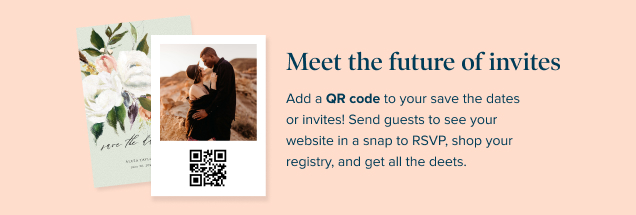- Expert advice/
- Invites & paper/
- Invitations/
- How to Address Wedding Invitations: Etiquette & Examples
- Invitations
How to Address Wedding Invitations: Etiquette & Examples
Master the art of addressing wedding invitations with proper etiquette. Learn formal and modern approaches to create elegant and inviting cards.
Last updated July 1, 2025
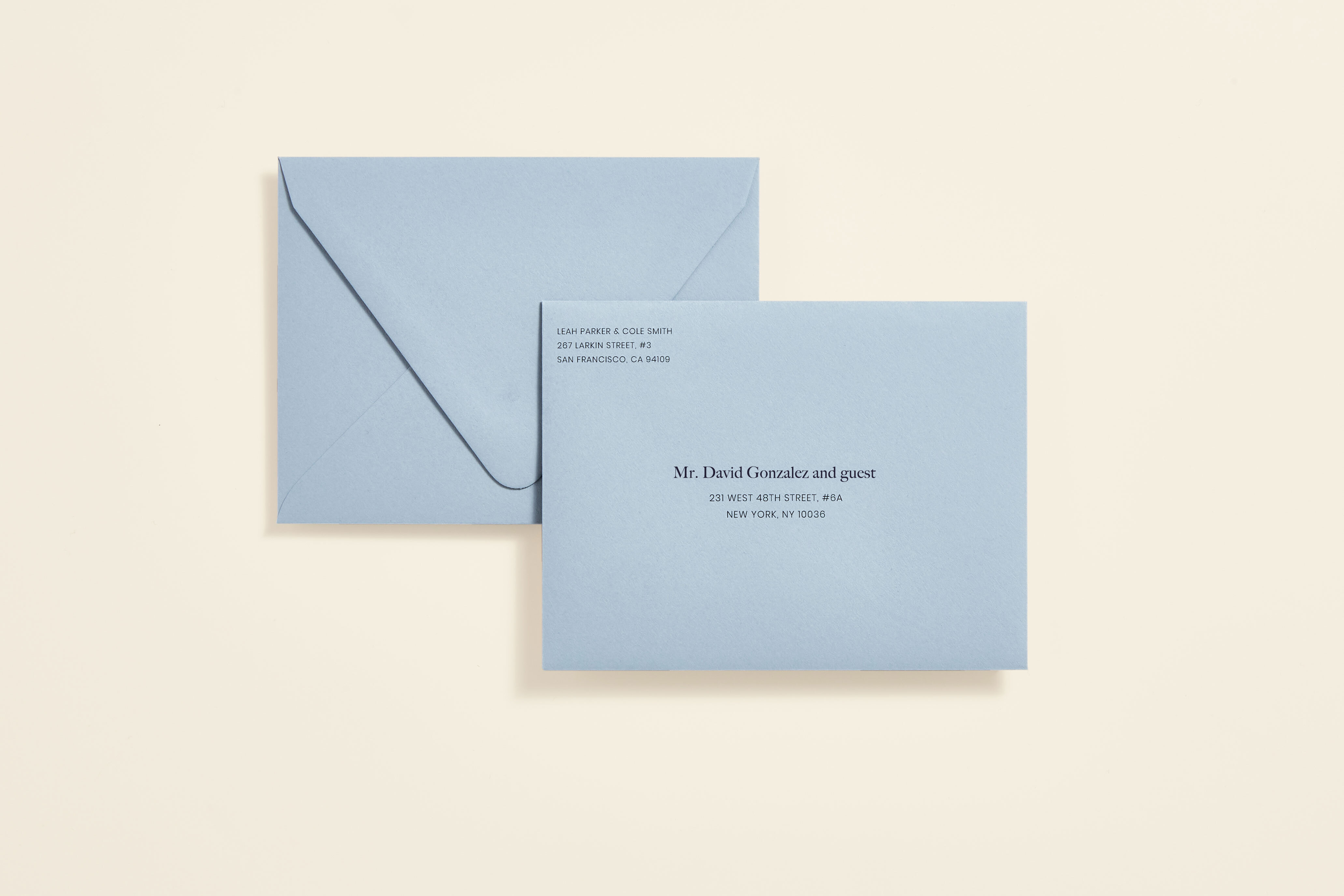
The First Look ✨
- Properly address your wedding invitations to ensure your wedding guests understand fully what you expect on your big day.
- A Formal wedding invitation usually includes an outer envelope with a more personalized inner envelope that includes the invitation, RSVP card, RSVP envelope, and any additional wedding stationery of your choice.
- An invitation addressed to families, couples, or a single guest can vary in specificity and it's best to use guidelines when addressing your envelopes wedding envelope.
Shop invitations
View allThe +1 Pledge
We’re showing the world some extra love by planting a tree for every paper order placed on Zola. Read more about our +1 Pledge here.
Anyone familiar with addressing an envelope is probably wondering how we have a full article on how to address wedding invitations. More goes into wedding invitation envelope wording than names and addresses and a postage stamp, though. Wedding planning involves a long to-do list and, often, a lengthy guest list. Make sure your own invitations get to your wedding guests with envelopes that appropriately call out their titles, relationship status, and similar. Below is our complete guide on how to address your wedding invitations.
General Rules for Addressing Wedding Invitations
-
If both names do not fit on Zola's template, try shortening the names
-
If you’re having a casual wedding, such as a backyard barbecue or brunch in the park, you might be able to get away with addressing your envelopes less formally, such as leaving off titles or just using first names. Otherwise, wedding etiquette suggests you err on the side of formality.
-
Avoid using nicknames or name abbreviations
-
Ensure you use the correct titles or prefixes (more on these below)
1. How to Address Wedding Invitations Without an Inner Envelope
Traditional wedding invitations have both an outer mailing envelope, which contains the mailing address, postage, and return address, and an inner envelope. The inner envelope is printed with only the recipients’ names, and contains all the pieces of the invitation suite: the invitation, RSVP card, RSVP envelope, and any additional enclosures such as a reception card, a map with directions, or invitations to additional weekend activities. When two envelopes are involved, the outside envelope is addressed more formally while the inside envelope is slightly more casual and frequently incorporates first names.
If you choose to send wedding invitations without an inside envelope, which is more common these days, simply focus on properly addressing the outer envelope.
2. How to Address Wedding Invitations To a Family
For One Envelope
-
When sending wedding invitations to a family, first decide whether you want to be specific about whom in the family is invited. If you don’t want to call out specific family members, simply address the envelope to the entire family:
-
The Simpson Family
-
If you do want to specify which family members are invited, write the names of each family member in list form. Begin your wedding invitation wording with the parent or parents’ names, and list invited children's name in order of age below. Female children under the age of 18 should be addressed as Miss:
-
The Simpson Family Mr. and Mrs. Homer Simpson Mr. Bart Simpson Miss Lisa Simpson
For Two Envelopes
-
If the whole family is invited, use the family name or only the names of the parents on the outer envelope:
-
The Simpson Family
—or— Mr. & Mrs. Homer Simpson
Then list the first names of all invited family members on the inner envelope:
- Mr. and Mrs. Simpson
Bart, Lisa, and Maggie —or— Homer, Marge, Bart, Miss Lisa, and Miss Maggie
General Rules for Addressing Wedding Invitations
-
If both guests' names don’t fit on one line, indent the second line.
-
If you’re having a casual wedding, such as a backyard barbecue or brunch in the park, you might be able to get away with addressing your envelopes less formally, such as leaving off titles or just using first names. But otherwise, err on the side of formality: people expect a bit more pomp and circumstance surrounding weddings, and older or conservative guests will take note if you are too informal.
-
How to Address Wedding Invitations to Married Doctors (or two!)
How to Address Wedding Invitations Without an Inner Envelope
Traditional wedding invitations have both an outer mailing envelope, which contains the mailing address, postage, and return address, and an inner envelope. The inner envelope is printed with only the recipients’ names, and contains all the pieces of the invitation suite: the invitation, RSVP card, RSVP envelope, and any additional enclosures such as a reception card, a map with directions, or invitations to additional weekend activities. When two envelopes are involved, the outside envelope is addressed more formally while the inside envelope is slightly more casual and frequently incorporates first names.
If you choose to send wedding invitations without an inside envelope, which is more common these days, simply focus on properly addressing the outer envelope. Below, we provide guidelines for how to address invitations with a single envelope vs. an inner and outer envelope for your reference.
How to Address Wedding Invitations To a Family
For One Envelope
-
When sending wedding invitations to a family, first decide whether you want to be specific about whom in the family is invited. If you don’t want to call out specific family members, simply address the envelope to the entire family:
- The Simpson Family
-
If you do want to specify which family members are invited, write the names of each family member in list form. Begin your wedding invitation wording with the parent or parents’ names, and list invited children's name in order of age below. Female children under the age of 18 should be addressed as Miss:
- The Simpson Family
Mr. and Mrs. Homer Simpson
Mr. Bart Simpson
Miss Lisa Simpson
*
- The Simpson Family
Mr. and Mrs. Homer Simpson
For Two Envelopes
-
If the whole family is invited, use the family name or only the names of the parents on the outer envelope:
- The Simpson Family
—or—
Mr. & Mrs. Homer Simpson
- The Simpson Family
-
Then list the first names of all invited family members on the inner envelope:
- Mr. and Mrs. Simpson
Bart, Lisa, and Maggie
—or—
Homer, Marge, Bart, Miss Lisa, and Miss Maggie
- Mr. and Mrs. Simpson
How to Address Wedding Invitations to a Married Couple
For One Envelope
-
If a married couple has the same last name, you can list them together just using the husband’s first and last name:
- Mr. and Mrs. Robert Belcher
- Mr. and Mrs. Robert Belcher
-
Or you can use BOTH the husband’s and the wife’s first and last names, if you’d prefer to address both partners equally:
- Mr. Robert Belcher and Mrs. Linda Belcher
—or—
Mr. Robert and Mrs. Linda Belcher
- Mr. Robert Belcher and Mrs. Linda Belcher
-
If a married couple has different last names, you can list either name first based on your preference, whomever your closest with, or the alphabet. “Mrs.” is traditionally used to indicate married women’s or men’s marital status:
- Mrs. Leslie Knope and Mr. Ben Wyatt
-
If one partner has a hyphenated name, list the hyphenated name last. Either “Ms.” or “Mrs.” can be used:
- Mr. Andy Dwyer and Ms. April Ludgate-Dwyer
-
If one partner is a judge, list the judge’s name first using the term “The Honorable,” and then use “Judge” for the inner envelope:
- The Honorable Ruth Bader Ginsberg and Mr. Martin David Ginsburg
-
If one partner has a distinguished title, such members of the clergy, rabbis, or military personnel, the distinguished title comes first regardless of gender:
- Rabbi and Mrs. Richard Glass
—or—
Rabbi Richard and Mrs. Rosina Glass
—or—
The Honorable Senator Elizabeth Ann Warren and Mr. Bruce Mann
- Rabbi and Mrs. Richard Glass
-
If both partners have distinguished titles, follow the same format as for medical doctors listed above regarding same or different last names. The higher-ranking title should come first, and if they are the same rank, traditionally the woman is listed first:
- Colonel Peter Jefferies and Reverend Margaret Jeffries
—or—
Lieutenants Amy and Jake Peralta
—or—
Captain Benjamin Pierce and Major Margaret Houlihan, US Army
- Colonel Peter Jefferies and Reverend Margaret Jeffries
For Two Envelopes
For outer envelopes, address them using the choices above for each married-couple scenario. For inner envelopes, you can be less formal though one of two options: titles + last names, or first names only (but only if you are very close with the couple). Here are examples of inner envelope addressing etiquette for married couples:
-
For a couple with the same last name:
- Mr. and Mrs. Belcher
—or—
Robert and Linda
- Mr. and Mrs. Belcher
-
For a couple with different last names:
- Mrs. Knope and Mr. Wyatt
—or—
Leslie and Ben
- Mrs. Knope and Mr. Wyatt
-
For a couple with a hyphenated last name:
- Mr. Dwyer and Ms. Ludgate-Dwyer
—or—
Andy and April
- Mr. Dwyer and Ms. Ludgate-Dwyer
-
For a couple with a judge:
- Judge Ginsburg and Mr. Ginsburg
-
For a couple with one distinguished title:
- Rabbi and Mrs. Glass
—or—
Senator Warren and Mr. Mann
- Rabbi and Mrs. Glass
-
For a couple with two distinguished titles, same last name:
- The Lieutenants Peralta
—or—
Colonel and Reverend Jefferies
- The Lieutenants Peralta
-
For a couple with two distinguished titles, different last names:
- Captain Pierce and Major Houlihan
How to Address Wedding Invitations to a Married Doctor (or Two!)
For One Envelope
If one partner is a doctor, list the doctor first regardless of gender. You can choose to spell out "Doctor" rather than hyphenate it to "Dr." if you would like to be more formal. Note that for academic doctors, you should always use the abbreviated "Dr." rather than spell it out. If the doctor is a woman and she has taken her husband's last name (or uses it socially), reflect that:
- Doctor Michaela Quinn and Mr. Byron Sully-or-Doctor Rainbow and Mr. Andre Johnson, Sr.-or-Doctor and Mrs. Perry Cox-or-Doctor Perry and Mrs. Jordan Cox
If both partners are doctors with the same last name, you can address their invite to the plural, non-abbreviated "Doctors" to be more formal. Traditionally the woman's name comes first:
- Doctors Monica and Alan Quartermaine-or-Drs. Monica and Alan Quartermaine
If both partners are doctors with different last names, traditionally the woman's name comes first, or you could list their names in alphabetical order:
- Dr. Meredith Grey and Dr. Derek Shepherd
For Two Envelopes
For a couple with one doctor:
- Dr. Quinn and Mr. Sully For a couple with two doctors, same last name:
- (The) Doctors Quatermaine For a couple with two doctors, different last names:
- Dr. Grey and Dr. Shepherd
5. How to Address Wedding Invitations to an Unmarried Couple
For One Envelope
-
If a couple is not married but living together, you have two options. You can either list their names alphabetically by last name on separate lines:
-
Mr. Ross Geller
Ms. Rachel Green
-
Or you can list both names on the same line, leading with whichever person you’re closest with. If you’re equally close with both, go alphabetical again:
-
Ms. Rachel Green and Mr. Ross Geller
-
If a couple is not married and do not live together, send a separate invitation to each guest.
For Two Envelopes
Follow the above guidelines for the outer envelope. For the inner envelope, as with above, use courtesy titles + last names or only first names if you are close with the couple.
- Ms. Green and Mr. Geller
—or— Rachel and Ross
6. How to Address Wedding Invitations to a Same-Sex Couple
For One Envelope
The same etiquette applies for same-sex couples as for any other couple, married or unmarried. If they’re married or live together, definitely list both names on the same line. If one partner has a hyphenated last name, list the hyphenated name last:
-
Ms. Susan Bunch and Ms. Carol Willik-Bunch
-
For a same-sex couple with different last names, you can list names either alphabetically or according to whichever guest you’re closest with:
-
Mr. Mitchell Pritchett and Mr. Cameron Tucker
For Two Envelopes
Follow the above guidelines for the outer envelope. For the inner envelope, as with above, use courtesy titles + last names or only first names if you are close with the couple:
- Mr. Pritchett and Mr. Tucker
—or— Mitchell and Cameron
7. How to Address Wedding Invitations to an Individual
For One Envelope
-
If the guest is an unmarried woman, use “Ms.” unless she is younger than 18—in this case, “Miss” spelled out is more acceptable:
-
Ms. Elizabeth Lemon
—or— Miss Donna-Jo Tanner
-
If the guest is a single male, use “Mr.” unless he is younger than 18—then no title is necessary
-
Mr. George Constanza
-
If your guest identifies as nonbinary, they have similarly simple rules to addressing women or men. Most often, you can use the honorific “Mx.” If you’re unsure, ask for their personal preference.
-
Mx. Courtney Andrews
-
If the guest is a widowed woman, it’s best to ask someone close to her if she prefers to still be addressed using her husband’s name, or if she prefers her married name. Some widows might also prefer to use “Ms.,” so be sure to inquire.
-
Mrs. George Devereaux
—or— Mrs. Blanche Deveraux
-
Similar options exist if the guest is a divorced woman: you can address her envelope using “Ms.” or “Mrs.” and either her ex-husband’s last name (if she still uses it) or her maiden name, depending on her preference.
-
Mrs./Ms. Cookie Lyon
—or— Mrs/Ms. Cookie Holloway
-
If the guest is a judge, use the term “The Honorable” before his or her full name:
-
The Honorable Sonia Sotomayor
-
If the guest is a priest, use the term “Father” before his full name:
-
Father Damien Karras
For Two Envelopes
The same traditional etiquette rules apply here as with couples when it comes to inner vs. outer envelopes. Outer envelopes follow the above suggestions. Inner envelopes either drop first names or just use first names—but only if you are very close with the individual. Here are examples of Inner envelope addressing etiquette for individuals:
-
For a single female:
-
Ms. Lemon
—or— Elizabeth
-
For a single female under 18:
-
Miss Chase
-
For a single male:
-
Mr. Costanza
—or— George
-
For a widow:
-
Mrs. Devereaux
—or— Blanche
-
For a divorced female:
-
Mrs./Ms. Lyon
—or— Mrs./Ms. Holloway
-
For a single judge:
-
Judge Sotomayor
-
For a priest:
-
Father Karras
8. How to Address Wedding Invitations With a Guest
For One Envelope
-
For guests to whom you’ve allowed a plus-one, send only one invitation—to the person you’re truly inviting—to that person’s address. If you know the name of the guest, include his or her name on the envelope as you would for an unmarried couple:
-
Ms. Jessica Spano
Mr. Albert Clifford Slater
- If you do not know the name of your friend’s guest, simply write “and guest” after your friend’s name. You do not capitalize either “and” or “guest:”
Mr. Zachary Morris and guest
For Two Envelopes
Outer envelopes follow the above rules, while inner envelopes drop the first names or, when you are very close with the guests, use first names exclusively:
- Ms. Spano
Mr. Slater —or— Jessie and A.C. —or— Mr. Morris and guest
From invitation templates, to proper addressing, to wedding invitation wording, Zola’s here to help you each step of the way. For answers to more questions—like, how do we share our wedding website?—look through our Expert Advice.
How to Address Wedding Invitations to an Unmarried Couple
For One Envelope
-
If a couple is not married but living together, you have two options. You can either list their names alphabetically by last name on separate lines:
- Mr. Ross Geller
Ms. Rachel Green
- Mr. Ross Geller
-
Or you can list both names on the same line, leading with whichever person you’re closest with. If you’re equally close with both, go alphabetical again:
- Ms. Rachel Green and Mr. Ross Geller
-
If a couple is not married and do not live together, send a separate invitation to each guest.
For Two Envelopes
- Follow the above guidelines for the outer envelope. For the inner envelope, as with above, use courtesy titles + last names or only first names if you are close with the couple.
- Ms. Green and Mr. Geller
—or—
Rachel and Ross
- Ms. Green and Mr. Geller
How to Address Wedding Invitations to a Same-Sex Couple
For One Envelope
-
The same etiquette applies for same-sex couples as for any other couple, married or unmarried. If they’re married or live together, definitely list both names on the same line. If one partner has a hyphenated last name, list the hyphenated name last:
- Ms. Susan Bunch and Ms. Carol Willik-Bunch
-
For a same-sex couple with different last names, you can list names either alphabetically or according to whichever guest you’re closest with:
- Mr. Mitchell Pritchett and Mr. Cameron Tucker
For Two Envelopes
- Follow the above guidelines for the outer envelope. For the inner envelope, as with above, use courtesy titles + last names or only first names if you are close with the couple:
- Mr. Pritchett and Mr. Tucker
—or—
Mitchell and Cameron
- Mr. Pritchett and Mr. Tucker
How to Address Wedding Invitations to an Individual
For One Envelope
-
If the guest is a single female, use “Ms.” unless she is younger than 18—in this case, “Miss” spelled out is more acceptable:
- Ms. Elizabeth Lemon
—or—
Miss Donna-Jo Tanner
- Ms. Elizabeth Lemon
-
If the guest is a single male, use “Mr.” unless he is younger than 18—then no title is necessary
- Mr. George Constanza
-
If the guest is a widow, it’s best to ask someone close to her if she prefers to still be addressed using her husband’s name, or if she prefers her married name. Some widows might also prefer to use “Ms.,” so be sure to inquire.
- Mrs. George Devereaux
—or—
Mrs. Blanche Deveraux
- Mrs. George Devereaux
-
Similar options exist if the guest is a divorced female: you can address her envelope using “Ms.” or “Mrs.” and either her ex-husband’s last name (if she still uses it) or her maiden name, depending on her preference.
- Mrs./Ms. Cookie Lyon
—or—
Mrs/Ms. Cookie Holloway
- Mrs./Ms. Cookie Lyon
-
If the guest is a judge, use the term “The Honorable” before his or her full name:
- The Honorable Sonia Sotomayor
-
If the guest is a priest, use the term “Father” before his full name:
- Father Damien Karras
For Two Envelopes
The same traditional etiquette rules apply here as with couples when it comes to inner vs. outer envelopes. Outer envelopes follow the above suggestions. Inner envelopes either drop first names or just use first names—but only if you are very close with the individual. Here are examples of Inner envelope addressing etiquette for individuals:
-
For a single female:
- Ms. Lemon
—or—
Elizabeth
- Ms. Lemon
-
For a single female under 18:
- Miss Chase
-
For a single male:
- Mr. Costanza
—or—
George
- Mr. Costanza
-
For a widow:
- Mrs. Devereaux
—or—
Blanche
- Mrs. Devereaux
-
For a divorced female:
- Mrs./Ms. Lyon
—or—
Mrs./Ms. Holloway
- Mrs./Ms. Lyon
-
For a single judge:
- Judge Sotomayor
-
For a priest:
- Father Karras
How to Address Wedding Invitations With a Guest
For One Envelope
-
For guests to whom you’ve allowed a plus-one, send only one invitation—to the person you’re truly inviting—to that person’s address. If you know the name of the guest, include his or her name on the envelope as you would for an unmarried couple:
- Ms. Jessica Spano
Mr. Albert Clifford Slater
- Ms. Jessica Spano
-
If you do not know the name of your friend’s guest, simply write “and guest” after your friend’s name. You do not capitalize either “and” or “guest:”
- Mr. Zachary Morris and guest
For Two Envelopes
- Outer envelopes follow the above rules, while inner envelopes drop the first names or, when you are very close with the guests, use first names exclusively:
- Ms. Spano
Mr. Slater
—or—
Jessie and A.C.
—or—
Mr. Morris and guest
- Ms. Spano
Shop invitations
View allUp next for you
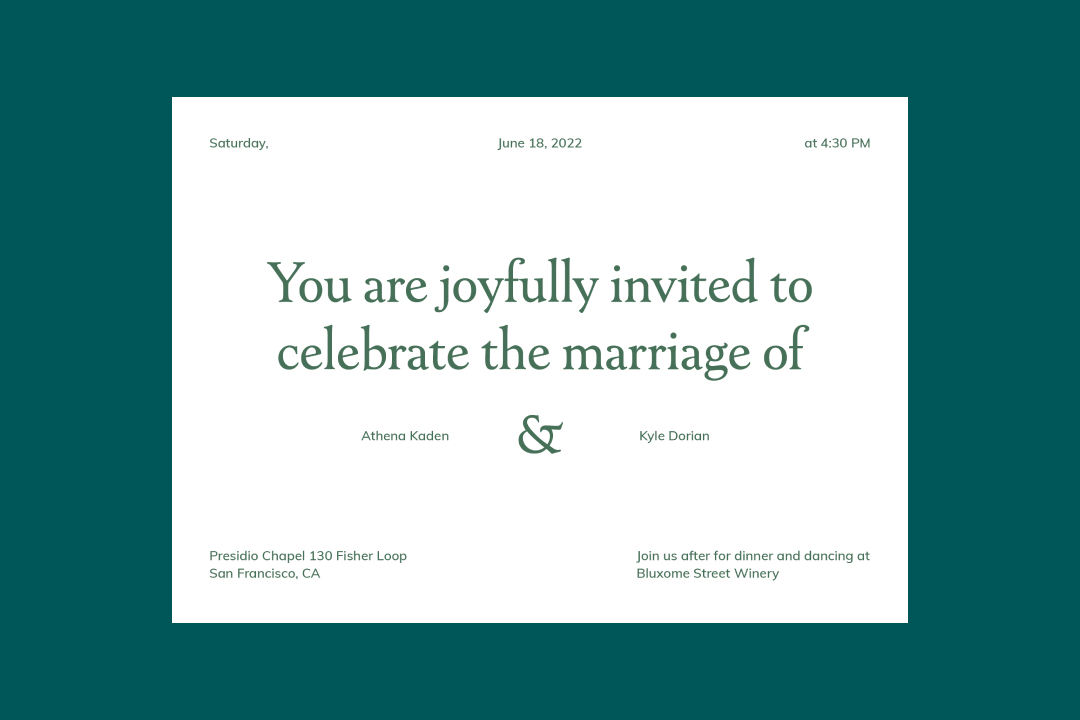
Wedding Invitation Wording: A Complete How-To Guide
How-To
Learn the how-to's of wedding invitation wording, plus formal and casual wedding invitation examples from the experts.

When to Send Out Wedding Invitations
Inspiration
When is it too early or too late to send out invites? Find out when to send wedding invitations and everything you need to consider for your planning timeline.
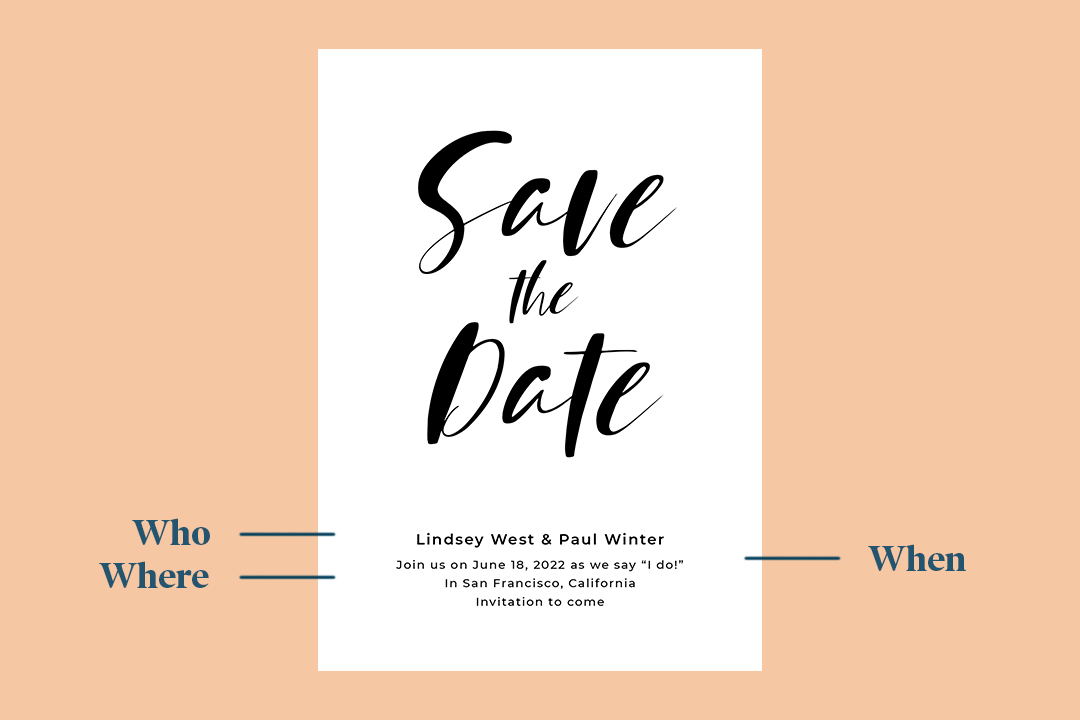
A Guide to Save The Dates
Inspiration
Save the dates add an extra touch of style and coordination to your wedding. Find out why and when you should send your save the dates with this complete guide.
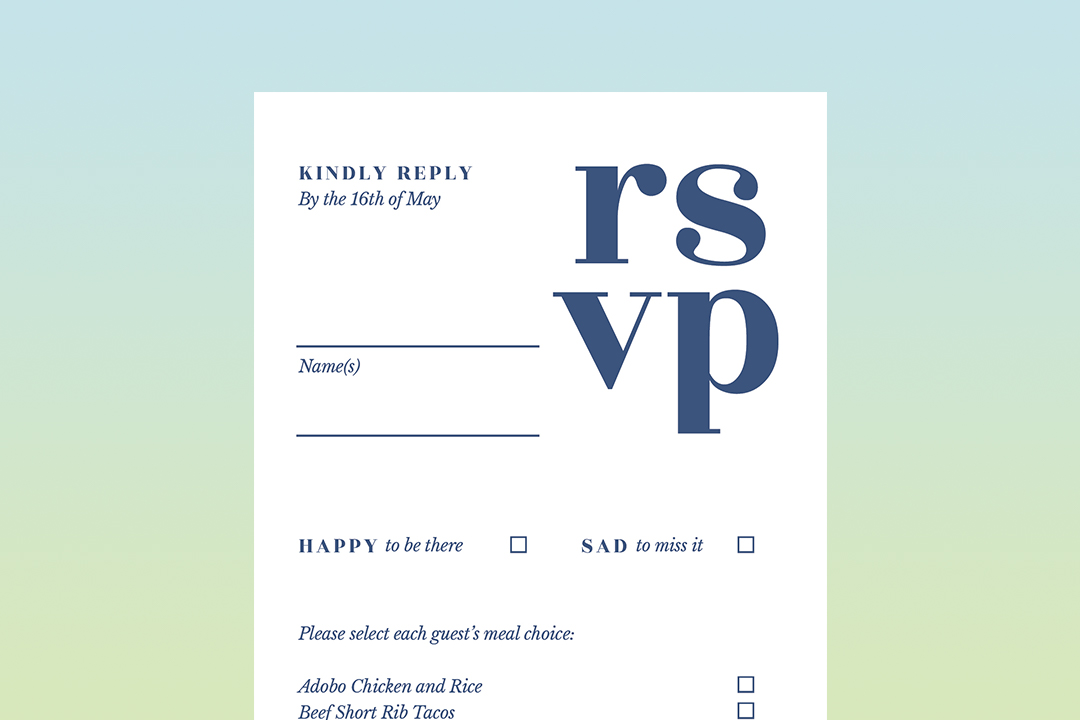
An Expert Guide to Wedding RSVP Cards & Complete Stationery Packages
Inspiration
Master wedding RSVP etiquette and discover complete wedding stationery packages with perfectly coordinated RSVP cards, free addressing, quality paper, and matching designs.
Featured

What Is a Registry (And Why Do You Need One)?
Inspiration
A wedding registry is a personalized collection of gifts that an engaged couple has specifically chosen for their guests to shop from in order to make the wedding gifting experience simpler, easier, and more satisfying for everyone.

A Guide to Bridal Showers
Inspiration
This bridal shower guide will introduce you to the basics of bridal showers: traditional bridal shower etiquette (and which of those “rules” you can break), whom to invite, what to do, and who pays for it all.

How to Plan a Wedding: A Step-by-Step Guide
How-To
We’ll walk you through the steps of online wedding planning, highlighting all of Zola’s incredibly easy and intuitive online wedding planning tools that’ll make planning for the big day more fun and less frustrating.

Wedding Cake Cost Guide: Average Price and Budget Tips
Advice
Wedding Cake Costs: Discover the national average of $917, typical range of $700 to $1,100, and smart ways to save on your wedding dessert.
- Expert advice/
- Invites & paper/
- Invitations/
- How to Address Wedding Invitations: Etiquette & Examples
Find even more wedding ideas, inspo, tips, and tricks
We’ve got wedding planning advice on everything from save the dates to wedding cakes.
